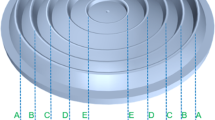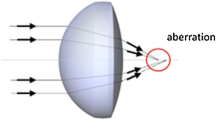Abstract
The purpose of this study is to establish a process window of injection molding process for the optimal form accuracy of spherical lenses. First, the significant factors influencing lens form accuracy are identified by Taguchi parameter design. These key factors are used to perform full factorial experiments and to establish the response surface model. Next, the concave response surface of form accuracy is obtained by Central Composite Design via sequential searching. The curve fitting is then used to obtain the injection molding process window for given spherical lens form accuracy. As a result, the injection molding process window is elliptical, the best form accuracy is 0.3758 μm at the elliptical center when the mold temperature is 85 °C, the cooling time is 9.6 s, and the packing time is 1.9 s. The average error is 7.92 % based on experimental verifications for three mold temperatures. In addition, a lens with a form accuracy of 0.5 μm is taken as an example to validate the injection molding process window. The results show that the average error between the experimental data and the prediction values is 10.58 %. Therefore, the proposed method for constructing a process window is reasonably accurate.
Similar content being viewed by others
References
Kurt M, Kaynak Y, Kamber OS, Mutlu B, Bakir B, Koklu U (2010) Influence of molding conditions on the shrinkage and roundness of injection molded parts. Int J Adv Manuf Technol 46:571–578
Park K (2004) A study on flow simulation and deformation analysis for injection-molded plastic parts using three-dimensional solid element. Polym-Plast Technol Eng 43:1569–1585
Li H, Guo Z, Li D (2007) Reducing the effects of weldlines on appearance of plastic products by Taguchi experimental method. Int J Adv Manuf Technol 32:927–931
Shieh JY, Wang LK, Ke SY (2010) A feasible injection molding technique for the manufacturing of large diameter aspheric plastic lenses. Opt Rev 17:399–403
Lu X, Khim LS (2001) A statistical experimental study of the injection molding of optical lens. J Mater Process Technol 113:189–195
Young WB (2005) Effect of process parameters on injection compression molding of pickup lens. Appl Math Model 29:955–971
Wang PJ, Lai HE (2007) Study of residual birefringence in injection molded lenses. SPE ANTEC Conf Proc, No. 2498
Taguchi G, Chowdhury S, Wu Y (2005) Taguchi’s quality engineering handbook. Wiley, Hoboken
Montgomery DC (2001) Design and analysis of experiments, 3rd edn. Wiley, New York
Peace GS (1993) Taguchi methods. Addison-Wesley, Taipei
Ozcelik B, Erzurumlu T (2006) Comparison of the warpage optimization in the plastic injection molding using ANOVA, neural network model and genetic algorithm. J Mater Process Technol 171:437–445
Tang SH, Tan YJ, Sapuan SM, Sulaiman S, Ismail N, Samin R (2007) The use of Taguchi method in the design of plastic injection mould for reducing warpage. J Mater Process Technol 182:418–426
Tsai KM (2010) Effect of injection molding process parameters on optical properties of lenses. Appl Opt 49:6149–6159
Altan M (2010) Reducing shrinkage in injection moldings via the Taguchi, ANOVA and neural network methods. Mater Des 31:599–604
Postawa P, Koszkul J (2005) Change in injection moulded parts shrinkage and weight as a function of processing conditions. J Mater Process Technol 162–163:109–115
Ozcelik B, Erzurumlu T (2006) Minimization of warpage and sink index in injection-molded thermoplastic parts using Taguchi optimization method. Mater Des 27:853–861
Deng CS, Chin JH (2005) Hole roundness in deep-hole drilling as analysed by Taguchi methods. Int J Adv Manuf Technol 25:420–426
Shiou FJ, Chen CCA, Li WT (2006) Automated surface finishing of plastic injection mold steel with spherical grinding and ball burnishing processes. Int J Adv Manuf Technol 28:61–66
Mahapatra SS, Patnaik A (2007) Optimization of wire electrical discharge machining (WEDM) process parameters using Taguchi method. Int J Adv Manuf Technol 34:911–925
Yang C, Hung SW (2004) Optimizing the thermoforming process of polymeric foams: an approach by using the Taguchi method and the utility concept. Int J Adv Manuf Technol 24:353–360
Li B, Nye TJ, Metzger DR (2006) Multi-objective optimization of forming parameters for tube hydroforming process based on the Taguchi method. Int J Adv Manuf Technol 28:23–30
Mok SL, Kwong CK, Lau WS (1999) Review of research in the determination of process parameters for plastic injection molding. Adv Polym Technol 18:225–236
Chen Z, Turng LS (2005) A review of current developments in process and quality control for injection molding. Adv Polym Technol 24:165–182
Myers RH, Montgomery DC (2002) Response surface methodology: process and product optimization using designed experiments, 2nd edn. Wiley, New York
Moore LJ, Sa P (1999) Comparisons with the best in response surface methodology. Stat Probl Lett 44:189–194
Bas D, Boyaci IH (2007) Modeling and optimization I: usability of response surface methodology. J Food Eng 78:836–845
Lizotte DJ, Greiner R, Schuurmans D (2012) An experimental methodology for response surface optimization methods. J Glob Optim 53:699–736
Chiang KT, Chang FP (2007) Analysis of shrinkage and warpage in an injection-molded part with a thin shell feature using the response surface methodology. Int J Adv Manuf Technol 35:468–479
Andrisano AO, Gherardini F, Leali F, Pellicciari M, Vergnano A (2011) Design of simulation experiments method for injection molding process optimization. Int conf Innov Meth Prod Des, Venice, Italy
Wang G, Zhao G, Li H, Guan Y (2011) Research on optimization design of the heating/cooling channels for rapid heat cycle molding based on response surface methodology and constrained particle swarm optimization. Expert Syst Appl 38:6705–6719
Wua L, Yick KL, Ng SP, Yip J, Kong KH (2012) Parametric design and process parameter optimization for bra cup molding via response surface methodology. Expert Syst Appl 39:162–171
Kwak JS (2005) Application of Taguchi and response surface methodologies for geometric error in surface grinding process. Int J Mach Tools Manuf 45:327–334
Kurtaran H, Erzurumlu T (2006) Efficient warpage optimization of thin shell plastics parts using response surface methodology and genetic algorithm. Int J Adv Manuf Technol 27:468–472
Kilickap E (2010) Modeling and optimization of burr height in drilling of Al-7075 using Taguchi method and response surface methodology. Int J Adv Manuf Technol 49:911–923
Tsao CC (2012) Evaluation of the drilling-induced delamination of compound core-special drills using response surface methodology based on the Taguchi method. Int J Adv Manuf Technol 62:241–247
Brient A, Brissot M, Rouxel T, Sangleboeuf JC (2011) Influence of grinding parameters on glass workpieces surface finish using response surface methodology. J Manuf Sci Eng 133. doi:10.1115/1.4004317
Pradhan MK (2013) Estimating the effect of process parameters on surface integrity of EDMed AISI D2 tool steel by response surface methodology coupled with grey relational analysis. Int J Adv Manuf Technol 67:2051–2062
Author information
Authors and Affiliations
Corresponding author
Rights and permissions
About this article
Cite this article
Tsai, KM., Tang, BH. Determination of injection molding process window based on form accuracy of lens using response surface methodology. Int J Adv Manuf Technol 75, 947–958 (2014). https://doi.org/10.1007/s00170-014-6185-9
Received:
Accepted:
Published:
Issue Date:
DOI: https://doi.org/10.1007/s00170-014-6185-9




